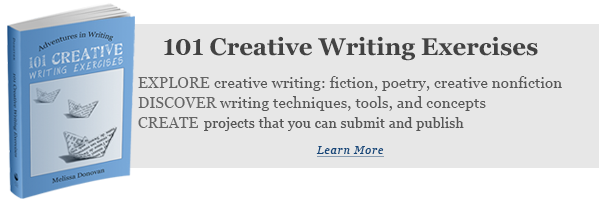Today I’d like to share a chapter from 101 Creative Writing Exercises. “Chapter 1: Freewriting” includes instructions for freewriting plus several variations and applications that you can use to make freewriting work for you.
Freewriting is one of the simplest, fastest, and most flexible creative writing exercises you can do. Use it for daily writing practice, idea development, and problem solving. I encourage all writers to give it a try.
Chapter One: Freewriting
Freewriting is one of the most creative and liberating writing exercises you can do.
Also called stream-of-consciousness writing, freewriting allows you to let your thoughts and ideas flow onto the page without inhibition. Anything goes. Turn off your inner editor and allow your subconscious to take over. The results can be inspiring, enlightening, and thought provoking.
Freewriting is ideal for daily writing practice. A twenty-minute freewriting session in the morning is a great way to capture your dreams or record your ideas before your head becomes cluttered with the day’s activities. A nighttime session is perfect for clearing your mind of the day’s clutter and for noting new ideas that have occurred to you throughout the day.
Guided freewriting is a bit different. As you write, you focus your attention on a specific idea, topic, or image. There are a number of variations on guided freewriting, which are explained in the variations section after the exercise.
With any kind of freewriting, you write quickly and let your thoughts flow freely. Remember, anything goes, even if it doesn’t make sense. Thoughts that sound ridiculous as you’re writing may gain meaning or clarity when you read the piece back later.
The Exercise
The process is simple. First, set a limit. Your limit is the minimum amount that you will write. Limits can be set in time, word count, or pages. Then write whatever comes to mind, no matter how outrageous. You will write up to your limit and if you want, you can exceed it. In other words, if you set a limit of ten minutes, you must write for at least ten minutes, but you can write for longer if you want.
The first few times you try freewriting, you might find that your mind goes blank at different points throughout your writing session. When this happens, don’t stop writing. Your pen should always be moving. If nothing comes to mind, write the word nothing over and over until your thoughts start flowing again. Just keep writing.
Tips:
What limits should you set? If you have a timer, try setting it for twenty minutes, which is a good amount of time for any writing session. Or fill two pages in your notebook, writing in longhand. If you’ll be writing electronically, then aim for five hundred words. You may want to experiment with how you set allotments for your freewriting sessions. Some writers find that anything beyond thirty minutes of freewriting becomes garbled; others find they hit their stride after the ten-minute mark.
Experiment with different writing tools. Many writers like writing in longhand for better creativity. If you write primarily on a computer, then give paper and pen a whirl for a few of your freewriting sessions.
Also, don’t give up after your first attempt at freewriting. Most writers who are new to freewriting find that it takes a few tries to get the hang of it.
Variations:
Below are a few examples of guided freewriting for creativity and problem solving:
Focused freewriting is writing around a certain idea or concept. If you’re working on a novel and your characters are stuck, a focused freewrite might help you break through the scene or move your characters to the next step. This is a bit like brainstorming except you write freely and continually, letting ideas stream instead of pondering them before committing them to the page.
Topical freewriting is writing about a specific topic or subject. If you’re working on an essay, you might engage in topical freewriting about the subject matter. This allows you to explore your thoughts and feelings and figure out which ideas and aspects of the subject you want to examine or address.
Words and imagery freewriting is great for poetry writing and useful if you’re writing nothing a lot in your general freewriting sessions. Choose a word or image and while you’re freewriting, keep your mind focused on it. If your mind goes blank during the freewrite, come back to the word and write it over and over (instead of nothing). Some examples: my body, apple tree, hummingbird, war, freedom, family, library, or museum.
Character freewriting helps you get to know your characters. There are two ways to do character freewrites. The first is to freewrite about the character. Write the character’s name across the top of the page, set your timer, and then write whatever comes to mind about the character. The second method for character freewriting is to write in first person as if you are the character. This brings you inside your character’s head to better understand his or her goals and motivations.
Solution freewriting is a technique for solving problems in your writing projects. Start by writing the problem across the top of the page. Try to form it into a question. Then write. Allow yourself to explore tangents and be emotional. You may find that you write yourself right into a solution. Some examples include the following: How can I explain the mystery I created for my story? What is missing from this poem? How can I better argue my position in this essay?
Applications:
Freewrites are perhaps best known for generating raw material that can be harvested for poetry. The nature of stream-of-consciousness writing lends itself well to poetry because freewrites tend to produce unusual or vivid images and abstract ideas.
Freewrites are also perfect for daily writing practice, especially when you don’t have a larger project underway or need a break from your regular writing routine.
Looking for more creative writing writing exercises that will inspire you and sharpen your writing skills? Pick up a copy of 101 Creative Writing Exercises, available at your favorite online bookstore.






One of the coolest things I’ve discovered about freewriting is what happens after I feel the urge to stop. I started out thinking I’d just finish the rest of the page, but now I deliberately work past that moment because the language and metaphor and surprises all seem to come there. Best reason for using a timer. 🙂
That happens to me with writing in general. On those days when I truly don’t feel up to writing — I’m tired or hungry or just not in the mood — I often produce my best work. It’s odd.
I’ve been looking for more and more creative writing exercises now that I’ve promised myself to write every day. I love free writing!
Me too. It’s one of my favorite writing practices.
I’m going to try the character free-writing. I think it’d be helpful in my WIP.
That’s awesome. Have fun with it!